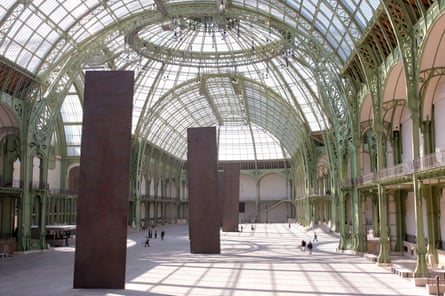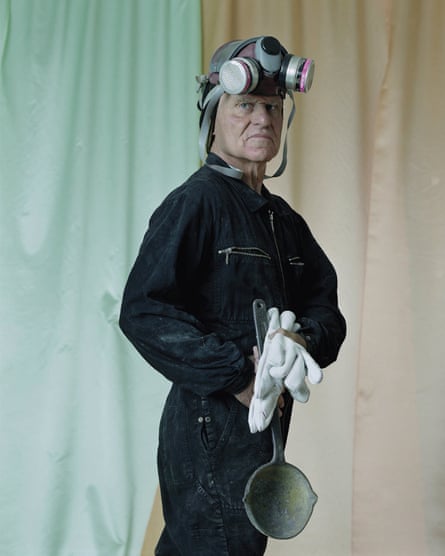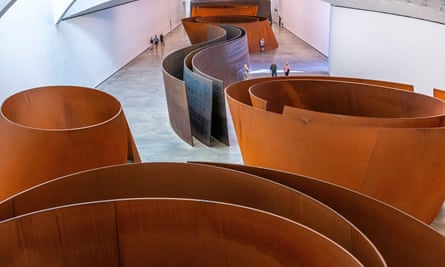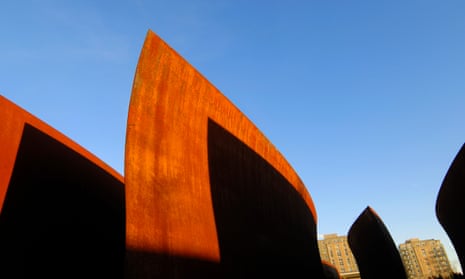What could seem more out of step or more timeless than Richard Serra’s work – with its obdurate metal blocks and curving steel walls that can feel as threatening as the side of a ship that curls above you as you flounder beneath? Serra’s sculptures are about as precarious as Stonehenge: they might last for centuries or even millennia – or fall and crush you to death in an instant. It is as if they were oblivious to human scale and the length of a human life. But without us, they are just ruins, remnants of overarching ambition. Most of them would survive our ending but there would be no one to witness them. There’s the paradox. Serra’s mighty works are nothing without us.
Le Corbusier’s architecture and early Morandi still lifes, Giorgio de Chirico’s paintings of vacant city squares and Giacometti’s figures standing still and walking; Georges Seurat’s conte crayon gradations and elegant atomised forms whose edges seem about to dissolve – they are all somewhere in Serra’s formation, created in a career that lasted more than 60 years. In many ways, he was a very European American artist. Serra, who died on Tuesday at the age of 85, was a daunting, fascinating artist. He made me think differently about space and sculpture – and about looking. Serra can make us feel physically and psychologically vulnerable, even though scaring us was never part of the point. Beyond all the analysis and critique, Serra’s sculpture is just there, like a rock or a cathedral.
Talking with Serra, who was born in San Francisco, the silences that fell were like ticking time-bombs. I dreaded an explosion. When I first met him in 1992, at the time of his simultaneous London exhibitions – one in the Duveen galleries at Tate Britain, the other at the Serpentine – I was extremely nervous. Like his art, Serra emanated seriousness. Both had gravity and gravitas. However obdurate and physically imposing, his art has great subtlety and a complexity that only emerges when you spend time with it. It has the capacity to slow us down, engaging us physically but also psychologically. It is always in the here-and-now but begs the idea of timelessness. It is direct, but invites misreading.

The two apparently similar blocks of steel that occupied the Duveen galleries in the Tate (now Tate Britain) in 1992 were actually of unequal size, one taller than the other, and they appeared to swell and contract as you moved around and between them. Is it me, I thought, or is it them? They seemed to do something to the boundaries of my own body. They refused clear recognition, even seeming to make the space around them expand and contract, depending on one’s constantly shifting viewpoint. Speaking of his drawings, he said that “all illusionistic strategies must be avoided”. It is us, the viewers, who find illusions.
I can’t forget Serra’s glee, in Paris, as he led me through a basement corridor and out into the blaring light falling through the glass Beaux Art roof of the Grand Palais to see his Promenade in 2008, with its five vertical slabs of Cor-Ten steel that stepped in and out of line along the building’s longest axis, like pedestrians anticipating one another’s movements on a busy pavement. They were also never quite vertical, leaning this way and that. The more time I spent there, as afternoon became evening and on into full dark, the more engrossed I was, the more complex the experience became.
after newsletter promotion

Serra liked the sudden astonishment of the first encounter – with work that looked like it was immovable and had been there for ever. That sudden sight of something precarious and inevitable and permanent is a recurring jolt. I think Serra enjoyed witnessing the affect his art had on others, the ways we interacted with his sculpture; he enjoyed the way we animated the space with our appearances and disappearances from view, our arrivals and departures. I enjoy watching other people’s encounters too, which are for me as much a part of the experience of his works as a lone journey among them. I enjoy how kids run between his towering walls, to discover what might happen around the next bend in the curve.
Sometimes these curves go on and on and double back. Sometimes we aren’t sure if we are inside or outside. Things bulge and move away from us in several directions at once. I enjoy watching people walking between his steel ramparts, their heads floating above his parapets, or being visually sliced off by a plane or a corner, as if they were edited and montaged in a silent, sped-up movie. Serra’s own early films, made in the 1970s, had a structural simplicity. His hand, full frame, clenches and unclenches as it attempts to catch scraps of lead falling in a blur from above. Both he and the camera try to capture their fall.
In Serra’s early sculpture there is leaning and balancing and rolling and propping, splashing and scattering and casting. Photographs show the artist in heavy protective apron and gloves, hurling molten lead from a ladle at the angle between the wall and the floor. Living on almost no money at all in a downtown New York loft in the late 1960s, Serra cadged the contents of a nearby rubber company that had closed down, carting all the sheets and scraps away, using it as his material.

Cutting, tying, letting the rubber droop and flop, and taking thicker sheets of the material and getting them to stand up, to find their own, thwunking topological forms, these rubber pieces led eventually to the use of curving steel forms, whose production only became possible decades later with the use of computer mapping. But much of Serra’s work was often more the result of pacing and placement by eye, frequently in collaboration with his wife, Clara Weyergraf, to whom he was married for more than 40 years. Technical difficulties and accomplishments were just the means.
Serra’s sculptures are not monuments. They are not symbolic. Nor are they picturesque follies or contrived ruins in the park. They are not theatrical. Standing beside his alignments of rolled-steel plates, his forged rhomboids and stubby cylinders, we sense their density – or like to think that we can. Perhaps this is just magical thinking, a little of which goes a very long way. Serra had the capacity to make you feel the weight of things and the spaces in between. His art alerts you to your own presence as well as that of the forms you share the space with. He makes us the subject of the work. His art makes me feel both embodied and weightless. But Serra’s objects aren’t the point. His was a double game, played with materiality and space, his intentions and our spectatorship. It goes on.

Comments (…)
Sign in or create your Guardian account to join the discussion